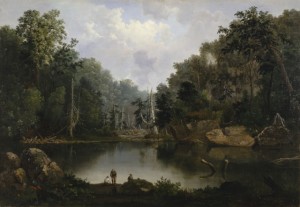Several news stories about Lake Erie’s algal bloom emanated this week from Gibraltar Island. I wasn’t familiar with that dateline. I thought I knew the Lake Erie islands, but it was new to me. Gibraltar Island is the site of the Stone Laboratory, Ohio State’s long-time field station on Lake Erie, the oldest freshwater field station in the United States. OSU owns the entire island – of course, The Ohio State University would own an island – designating it “the Lake Erie campus.”
One of the news stories references “an annual two-day science and environmental writers’ gathering” held this week at the Stone Lab. I’ve searched for more information about this meeting and how to attend it, but haven’t found any ready answers. As my Lake Erie writing project develops, I’d like to plan to attend this meeting in the future. If any reader has details, please let me know.
- Lake Erie algal bloom could grow difficult – Toledo Blade 082715
GIBRALTAR ISLAND, Ohio — It’s huge, and it’s probably getting bigger until the first of October. | But the 2015 western Lake Erie algal bloom has actually been a fairly easy tiger for area water-treatment plant operators to tame so far, according to Kelly Frey, Ottawa County Sanitary Engineer. | The hefty biomass that the National Oceanic and Atmospheric Administration expects to be the second largest bloom on record is producing the harmful algal toxin microcystin but not in a concentration strong enough yet to push water-treatment plants to their maximum capability, Mr. Frey said. | Experts are still working to determine what that maximum capacity will be, Mr. Frey said Tuesday in a presentation to about 30 journalists, scientists, and outreach specialists at Ohio State University’s Stone Laboratory on Gibraltar Island, during the first day of an annual two-day science and environmental writers’ gathering.
- National Center for Water Quality Research | Heidelberg University
The National Center for Water Quality Research (NCWQR) is a leader in surface and ground water research and monitoring in the Great Lakes region and beyond. Chemical analysis of freshwater samples, biological assessment of aquatic communities, and watershed modeling are performed at our facilities in Gillmor Hall on the Heidelberg University campus. | The NCWQR staff uses the wealth of water quality data that is generated here concerning Lake Erie and numerous streams and groundwater wells across the nation to understand and interpret the impacts of food production on soil and water resources, the status of water quality, the effects of water quality on aquatic ecosystems, and future implications for the availability of healthy, usable water.
- About Stone Laboratory (Lake Erie) | OSU
Established in 1895, Stone Laboratory is the oldest freshwater biological field station in the United States and the center of Ohio State University’s teaching and research on Lake Erie. The lab serves as a base for more than 65 researchers from 12 agencies and academic institutions, all working year-round to solve the most pressing problems facing the Great Lakes. In addition to its role as a research facility, Stone Lab offers 25 college-credit science courses each summer for undergraduate and graduate students, advanced high school students and educators. The hands-on sessions get students out into the field or out on the lake to study courses including biology, geology and natural resources.
- Stone Laboratory on Twitter (@stonelab)
- Lake Erie algae bloom spreads to Cleveland, could set record, scientists warn | Cplumbus Dispatch 082715
GIBRALTAR ISLAND – Scientists who study Lake Erie say this summer’s growing toxic bloom is almost certain to be the worst on record. | The bloom, which started in the western part of the lake in June, has stretched to Cleveland and could still grow. The mass is on pace to peak in September. | Scientists originally thought the bloom would be about average this year, but heavy, sustained rains in June and July washed large amounts of phosphorus into the watersheds that feed the lake. | “All that rain just increased the load,” said Chris Winslow, interim director at Ohio Sea Grant and Ohio State University’s Stone Laboratory, which study the lake. | Algae feed, in part, on phosphorus, a key ingredient in manure, farm fertilizers and sewage. When phosphorus levels began to rise, scientists say, it became clear that this year’s algae bloom would be bad. | Still, they originally thought the bloom would be smaller than the record-setting one in 2011. The levels of phosphorus were high this year, but not as high as 2011 levels. | But new data about the amount of phosphorus that ended up in the lake show that this summer’s bloom likely will top 2011’s bloom. The data show that dissolved reactive phosphorus reached the lake in the largest amounts in recent history. | Dissolved phosphorus is blue-green algae’s favorite form of phosphorus to consume, said Laura Johnson, a research scientist at Heidelberg University’s National Center for Water Quality Research, which monitors watersheds around Lake Erie. | The more fuel for algae, the larger the bloom. Large blooms can sicken people and hurt the summer tourism season at the lake, which already suffers from bacterial issues on its beaches. | Blue-green algae produce microcystin, a toxin that makes people sick and can kill pets. Microcystin contaminated Toledo’s drinking water in August 2014, forcing city officials to tell nearly 500,000 people to stop using their taps. | Scientists, including Johnson and former Stone Laboratory director Jeff Reutter, are meeting in Canada today to work on solutions to the lake’s perennial algae problem. | Those scientists have recommended cutting the amount of phosphorus that reaches Lake Erie by 40 percent from 2008 levels in order to reduce algae. | To do that, farmers will have to change the way they operate. Scientists say manure and fertilizers that wash from farm fields are responsible for a large portion of the phosphorus that gets into the lake. | Ohio State and other universities are studying ways farmers can keep phosphorus out of the Lake Erie watershed. | Winslow said soil testing could help. If farmers know how much phosphorus already exists in their soil, he said, they won’t need to add more than the soil needs to grow crops.
- Algal bloom spreading into Lake Erie’s central basin | Sandusky Register 082415
The harmful algal bloom in Lake Erie is growing and has spread into the central basin, the National Oceanic and Atmospheric Administration says. | People and pets should stay out of the water in places where scum has formed, NOAA says in a bulletin the agency issued Monday. | “The Microcystis cyanobacteria bloom continues across a large part of the western basin along the Michigan and Ohio coasts and into the central basin. The recent southwesterly winds have pushed the bloom northward along the Michigan coast. Moderate to high concentrations extend eastward to midway between Cleveland and Rondeau, Ontario. Scum has been scattered in the last few days,” the bulletin says.
About the images: [Above] Aerial view of Gibraltar Island, site of the Stone Laboratory, Put-in-Bay, Lake Erie. [Source: marietta.edu]; [Below] Map of Lake Erie’s South Bass Island showing Gibraltar Island in Put-In Bay. [Source: [Pinterest]
![Aerial view of Gibraltar Island, site of the Stone Laboratory, Put-in-Bay, Lake Erie. [Source: marietta.edu]](https://www.ghostturtles.com/wp-content/uploads/2015/08/Gibraltar-Island-aerial-view-1-300x197.jpg)
![Map of Lake Erie's South Bass Island showing Gibraltar Island in Put-In Bay. [Source: [Pinterest]](https://www.ghostturtles.com/wp-content/uploads/2015/08/Put-In-Bay-map-1-300x196.jpg)


![Sandhill cranes land on Platte River sandbar roosts west of Rowe Sanctuary’s Iain Nicolson Audubon Center southwest of Gibbon, Nebraska. [Photo by Lori Porter| Kearney Hub]](https://www.ghostturtles.com/wp-content/uploads/2015/03/sandhill_cranes_kearneyhub_032015-300x225.jpg)
![An endangered Whooping crane takes flight. Yhe large bird has a 7-foot wingspan. It is all white except for black wing tips and face markings. In this photo its long neck stretches forward; its wings sweep upward; and its black legs trail straight behind it. [Source: International Crane Foundation]](https://www.ghostturtles.com/wp-content/uploads/2023/03/Whooping-crane-eastern-ICF-080622-300x157.jpg)

![Mark Willis peruses a 1745 volume by Voltaire at a bouquiniste book stall on the banks of the Seine in Paris. He wears a brown leather jacket and checkered flat cap. He holds the open book in his hands. Rows of old books are seen on shelves behind him. [2005 photo by Ms. Modigliani]](https://www.ghostturtles.com/wp-content/uploads/2023/03/mw_bouquiniste_05-300x225.jpg)


